Nestled in the heart of Provence, the charming village of Cucuron offers a picturesque escape into historical elegance and natural beauty.
The village streets, a labyrinthine maze flanked by buildings steeped in history, lead to the iconic Bassin de l’Étang, a reservoir surrounded by ancient plane trees, doubling as a serene spot of leisure and a remnant of the village's milling past.
Architectural marvels, such as the Renaissance Maison d’En-Bas des Seigneurs, the Consuls Mansion and the truncated Donjon Saint-Michel, stand testament to the village's aristocratic legacy.
Furthermore, Cucuron's quaint lanes are dotted with local businesses, from boulangeries to a butcher's shop, adding a lively community spirit to its historic backdrop.
Overlooking the Luberon range, Cucuron not only captivates with its aesthetic allure but also with tales of its past, making it a must-visit for those enchanted by the depths of French provincial life.
Watch this short video on the Luberon!
Why I like visiting Cucuron
My initial encounter with the enchanting village of Cucuron was through Claire, a local who had worked with us at our French language centre in Sydney, Australia.
Her stories painted a picture of a place where history and beauty intertwined, compelling me to visit for the first time in 2011.

Arriving in Cucuron © French Moments
The charm of Cucuron captivated me immediately, with its serene Bassin de l’Étang framed by centuries-old plane trees and the maze of narrow streets whispering tales of times gone by.
Over the years, I found myself drawn back to this picturesque village, with each visit revealing more layers of its rich heritage and vibrant community life.
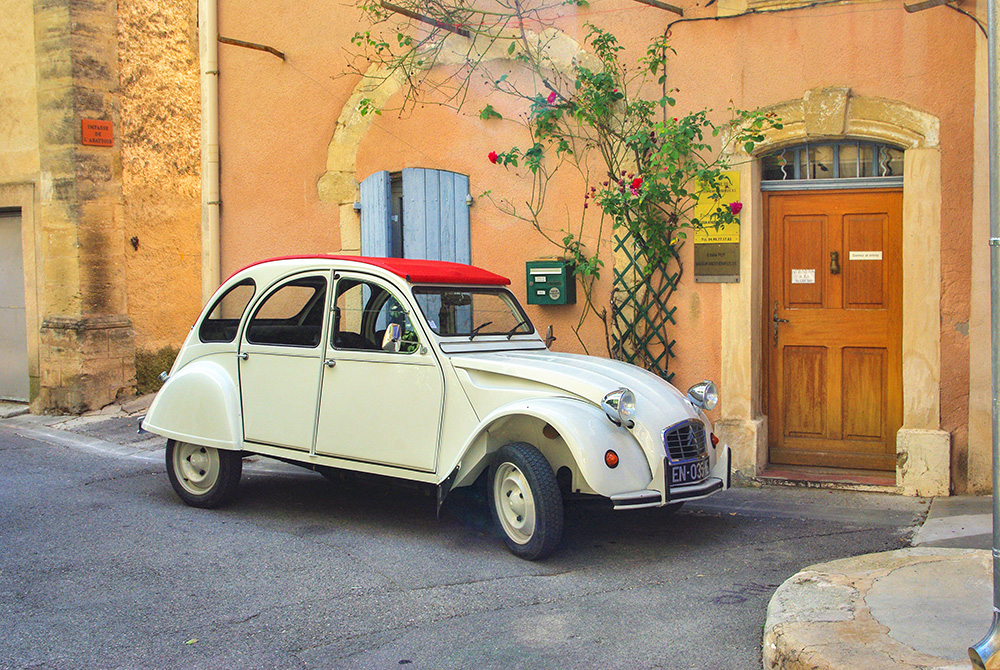
A Citroen 2CV in Cucuron © French Moments
My last visit, in October, was graced with sunshine, perfect for capturing the village’s beauty in photos and a guided tour film that I later published on YouTube.
Strolling through the lanes, past the old mansions, the Clock Tower and up to the remnants of the castle, I felt a deep connection to Cucuron, a place where every corner holds a story, every stone a memory.
It’s a village that stands as a testament to the enduring allure of Provence, inviting visitors to step into a world where history, nature, and the warmth of its people create a tapestry of unforgettable experiences.
Plan your trip
- 🛏 Find the best accommodations in the Luberon on Booking.com
- 🚙 Rent a car in Aix-en-Provence or Marseille-Provence Airport
- 🙋♀️ Get the PASS CÔTE D'AZUR and take your pick from more than 100 amazing experiences!
- 🤩 Visit the beautiful Provençal region of Luberon
- 🚐 Join a 6-hour tour of Lourmarin, Bonnieux, Roussillon, and Gordes by air-conditioned minibus
- 🚘 Discover Provence in a 2CV. Stroll along exceptional roads and enjoy a piece of Luberon all to yourself!
- 🥗 Experience a black truffle hunting tour in a Luberon plantation
- 📚 Read the DK Eyewitness Provence and the Côte d’Azur Travel Guide
- 🗺 Download the touristic map of Cucuron
- 🚻 Public toilets are located at Place de l'Étang and Parc de la Ferrage.
- 🚗 Park at the entrance to the old medieval centre: Circular Boulevards (Boulevard du Sud, Boulevard du Nord, Cours de Pourrière, Cours Saint-Victor) and Place de l'Étang.
Cucuron: A Bit of History
Cucuron, a village with a tale as rich as the Provencal landscapes it inhabits, first entered the annals of history in 1004 through a charter of donation to the Monastery St Pierre de Psalmody, a Benedictine abbey of considerable influence near Aigues-Mortes.
The initial fortified urban core, or “castrum,” began its ascent during the 11th century, spiralling in concentric circles around the castle perched on the western hill of the site.
The beginnings in the 11th and 12th centuries
The parish church of St Michel, nestled against the ramparts, emerges in historical texts by 1099; it's possible it was constructed in the earlier half of the century, preceding the arrival of monks from St Victor de Marseille in 1055, who established a priory dedicated to their patron saint in the Quartier St Victor, to the southeast of the village.
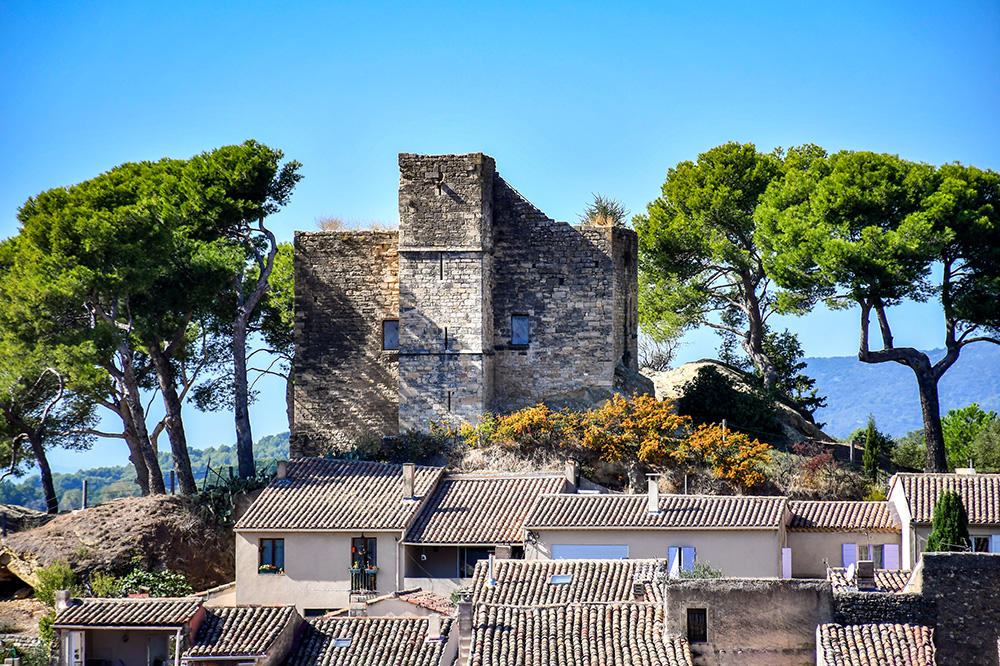
Donjon Saint-Michel © French Moments
As the 12th century unfurled, the so-called family of Cucuron, descendants of Lambert de Reillanne, witnessed a significant erosion of their power to the Count of Forcalquier. They retained only minor rights until their line’s cessation in the 15th century.
In 1193, Guillaume II of Forcalquier ceded the lordship of Cucuron to Guillaume de Sabran, integrating it into the barony of Ansouis.
A prosperous town
Cucuron swiftly outgrew its initial bounds, morphing into a town. The neighbourhoods fanning out from the central hill were likely established in the 12th century and encircled by fortified walls in the early 13th century.
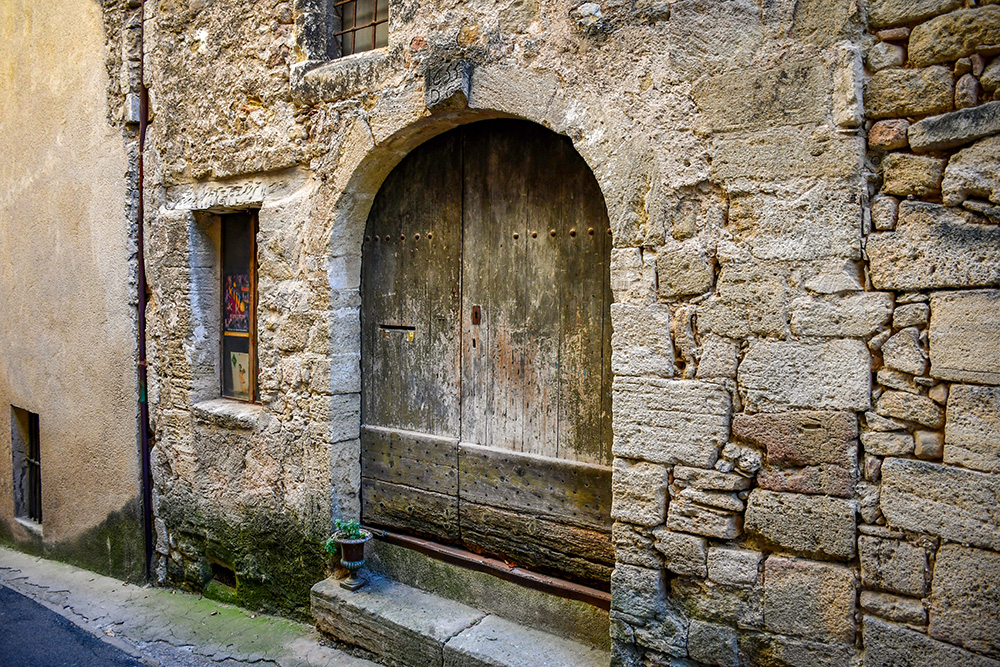
An old street in Cucuron © French Moments
By then, the urban sprawl had breached these fortifications, inching eastward towards the newly erected Notre Dame de Beaulieu church on the eastern hill to accommodate the growing population beyond the capacity of the old St Michel parish.
The Consuls of Cucuron
The burgeoning settlement demonstrated its vitality and significance through the formation of a consulate – an urban oligarchy asserting political stewardship over the city.
Southern France's consulates peacefully and gradually distanced themselves from feudal dominion.
By 1275, consuls were sharing the administration of lower justice, or policing, with the lords. Commerce began to thrive, drawing a Jewish community by 1299, residing in what was then known as the street of "Jutarié" (now Rue du Tubet).
The 14th century
Entering the 14th century, Cucuron boasted over a thousand inhabitants. Extensive documents from this era detail the gradual expansion of the settlement from the Portail de l’Horloge to the Vaureilles area, south of the Notre Dame de Beaulieu church.

Place de l'église in Cucuron © French Moments
In the mid-14th century, Cucuron, like the rest of Provence, faced a protracted economic and demographic downturn exacerbated by epidemics, civil wars, and the marauding "Grandes Compagnies".
Ferrier de Cucuron, co-lord of the village, attempted to resist Arnaud de Cervole, a notorious Gascon bandit known as "l’archiprêtre", but was defeated beneath the village's ramparts.
At odds with the Count of Provence, mercenaries of Raymond, Viscount of Turenne, set the castle ablaze and inflicted damage on St Michel church, Cucuron’s initial parish.
Baron Elzéar III de Sabran extended several concessions to the village community, including grazing lands, wastelands, and other seigniorial rights.
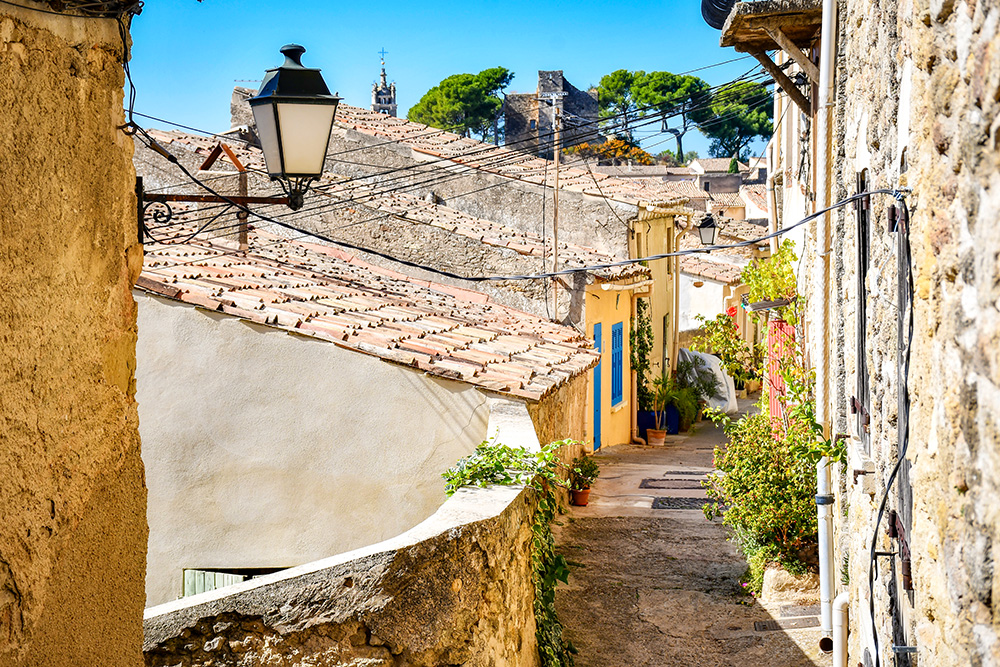
An old street in Cucuron © French Moments
The Castillon family
In 1443, Elzéar lost the lordship of Cucuron, seized for debts by an Avignon merchant, André Esquirol. His widow promptly sold it to an Italian-origin noble, Nicolas de Castillon.
He managed to prevent Cucuron, as decreed by King René, from being annexed to the royal domain.
The Castillon family played a significant role in Cucuron until the early 17th century.
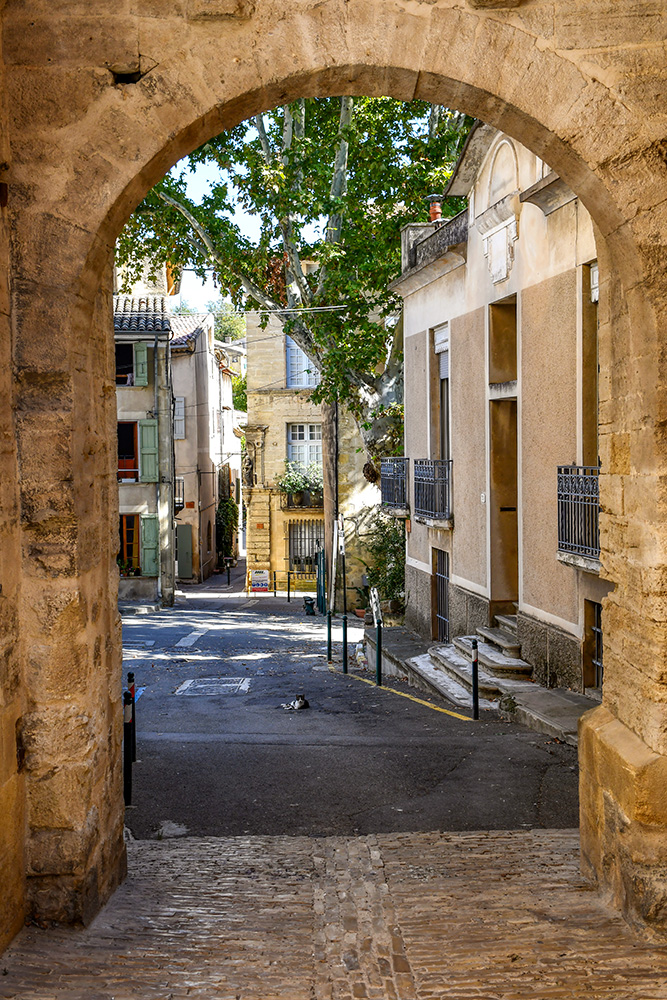
Under the clock tower © French Moments
The 15th and 16th centuries
In the last quarter of the 15th century, a recovery was felt. The community undertook a long series of works, culminating in 1541 with the construction of the communal belfry and a new fortified enclosure that included the vast suburb east of the old town.
The 16th century brought rivalry between François I and Charles V, leading to an inevitable war. The Constable of Bourbon, having switched to the emperor's side, attempted to conquer Provence.
Charles V's troops invaded in 1536 but were repelled at the walls of Cucuron and driven back to the Durance River.
The Wars of Religion
During the Wars of Religion, Catholic Cucuron sided with the League (the Catholic party against Protestantism).
Despite the heavy contributions demanded from its inhabitants, the town continued to grow.
The 18th century
By then, the population had reached nearly 2,000 people. Growth continued into the early 18th century, reaching 3,000 inhabitants. Much agricultural land had passed to nobles or bourgeois, with large country houses (37 by 1703) replacing the many small peasant dwellings of the late 16th century.
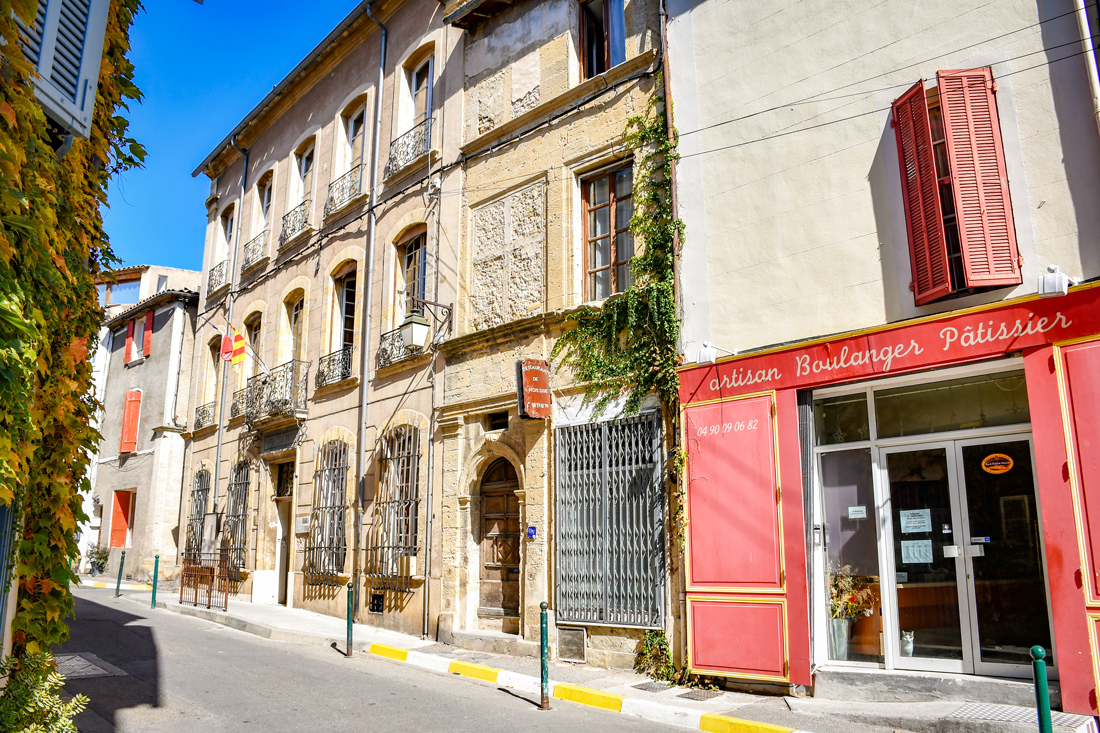
The Town Hall of Cucuron © French Moments
It was a town weakened by the economic crisis of the early 18th century, and the plague from Marseille ravaged it from October 1720 to October 1721, causing nearly a thousand deaths among the population.
Shortly before the Revolution, the Lordship was sold to the Baron de La Tour d'Aigues, Jean Baptiste Jérôme de Bruny, who was the last lord of Cucuron before the night of August 4, 1789 (the abolition of nobility privileges).
A priest from Cucuron, Abbé Charles Cousin, was elected by the clergy of the Sénéchaussée of Aix as a deputy to the Estates-General of May 1789.
The 19th and 20th centuries
The end of the 19th and the beginning of the 20th centuries marked a lengthy period of adjustment for the village to new structures and progress.
The rural exodus was particularly pronounced and enduring as the commune lacked commercial or industrial structures and land suitable for speculative agriculture.
The population, around 2,200 in 1830, had fallen to less than 1,100 by 1918. By 1936, there were only 939 inhabitants.
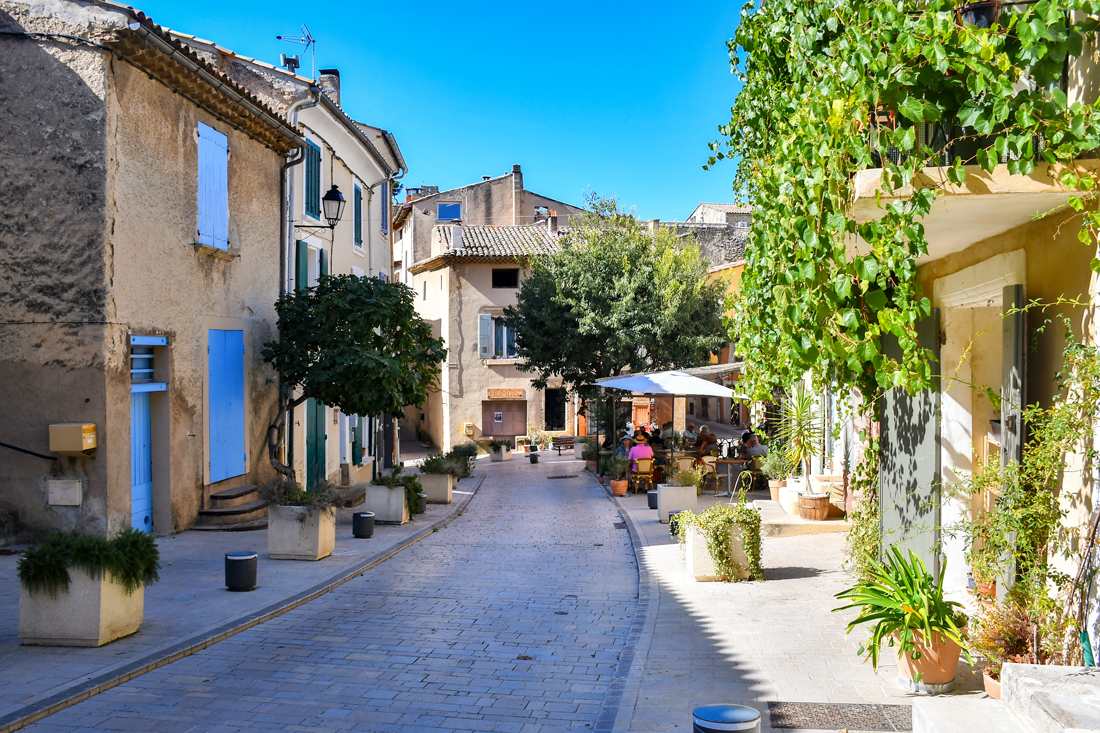
Rue de l'église © French Moments
The village was modernised after the Second World War by introducing running water, sewage systems, and street paving.
Secondary residents restored homes in the old quarters. At the same time, new buildings sprouted in the peripheral areas and to the east of the village, signalling a slow but steady revival and adaptation to the changing times.
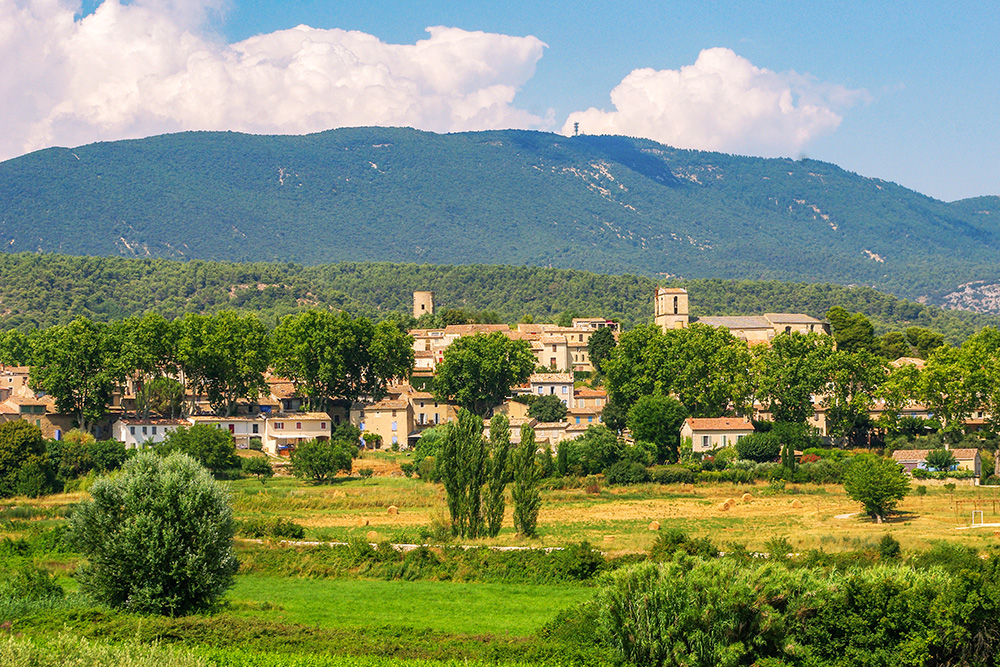
Cucuron © French Moments
The Discovery Guide of Cucuron
Here's some tourist information to help you explore the Provencal village.
🎦 Check out my guided walk on YouTube to explore Cucuron with me:
Understanding the Village
Cucuron is perched between two hills:
- one basking in the sunset's glow, crowned by the remnants of a medieval castle (Donjon Saint Michel).
- and the other greeting the sunrise, adorned with the Notre Dame de Beaulieu church and the Citadel Tower: this is the Pous district.
Let's start our exploration with the iconic Bassin de l'Étang to the north of the village.
Bassin de l'Étang
The Bassin de l’Étang was originally a reservoir collecting water from various sources in the Luberon, intended to supply the flour mill.
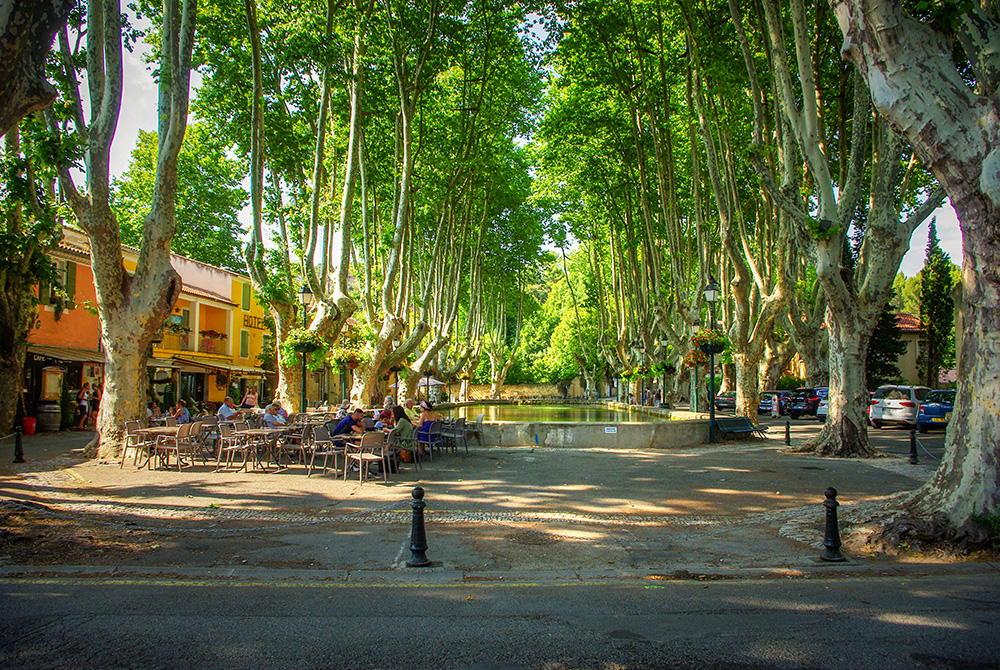
The Bassin de l'Étang in Summer © French Moments
The pond has existed since 1403 and was acquired by the municipality in 1515. The basin was then arranged and encircled by a causeway.
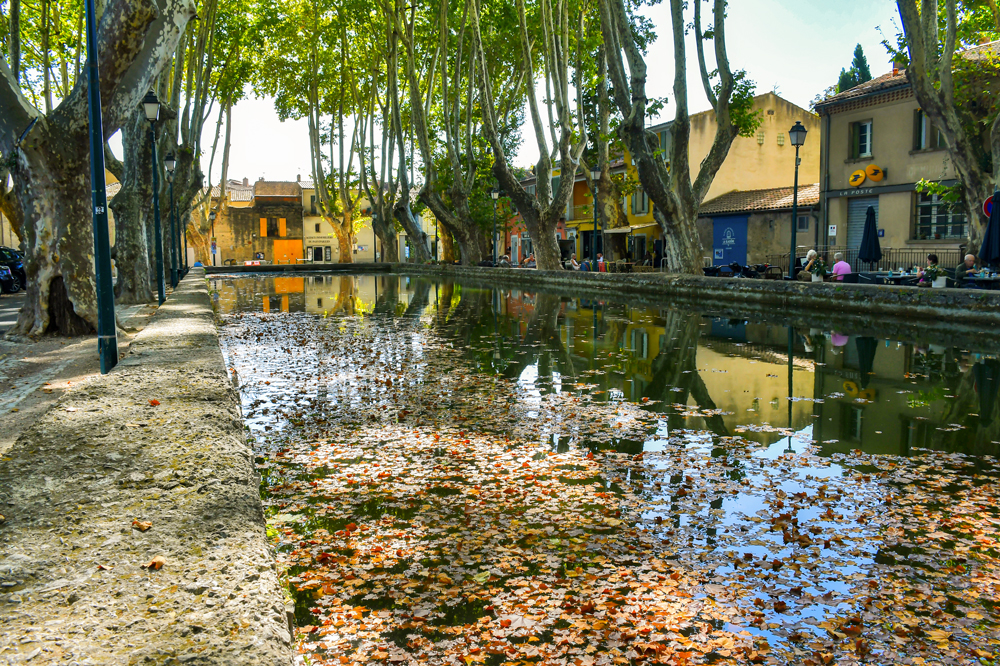
Bassin de l'Étang © French Moments
After the mills were decommissioned in the 19th century, the Bassin de l’Étang became a place for leisure.
The plane trees were planted in 1813, making them over two centuries old. The Bassin de l’Étang was classified as a historical site in 1954.
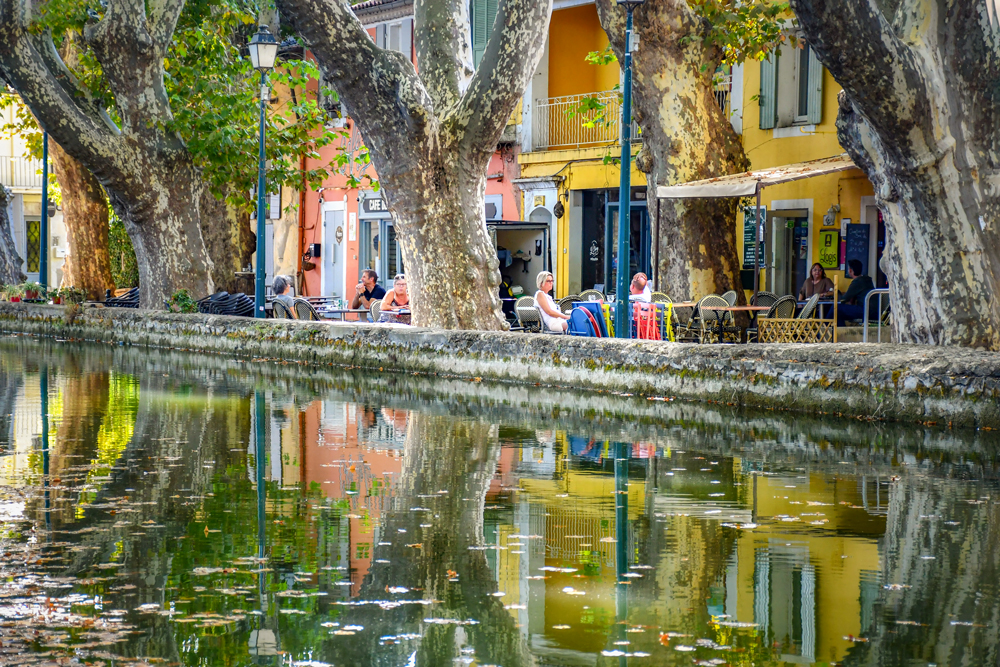
The Bassin de l'Étang in autumn © French Moments
It was here that a scene from Ridley Scott's movie, A Good Year, starring Russell Crowe and Marion Cotillard, was filmed in 2005.
The Ramparts of Cucuron
As you explore Cucuron, you will see the remains of the ramparts on numerous occasions. Here's what you need to know to understand this medieval site better.

An informative panel showing the fortifications of Cucuron
The ramparts of Cucuron were built in three periods:
- The first wall surrounded the hillock of Saint Michel, where the feudal castle from the 11th century was located.
- The second wall of the 12th and 13th centuries still surrounds parts of the keep mound.
- The third wall from the 16th century, built in the period leading up to the wars of religion, is the best preserved. It featured four gates and six towers, including the Portail de l’Etang, the Portail de Ginous, and the Citadel Tower. The structure consisted of a 9-metre high wall, a walkway, and several machicolations and was doubled on the outside by a dry moat.
Portail de l'Étang
The Portail de l’Étang is a fortified gateway that dates back to 1541 and is one of the two remaining gates from the 16th-century fortification.
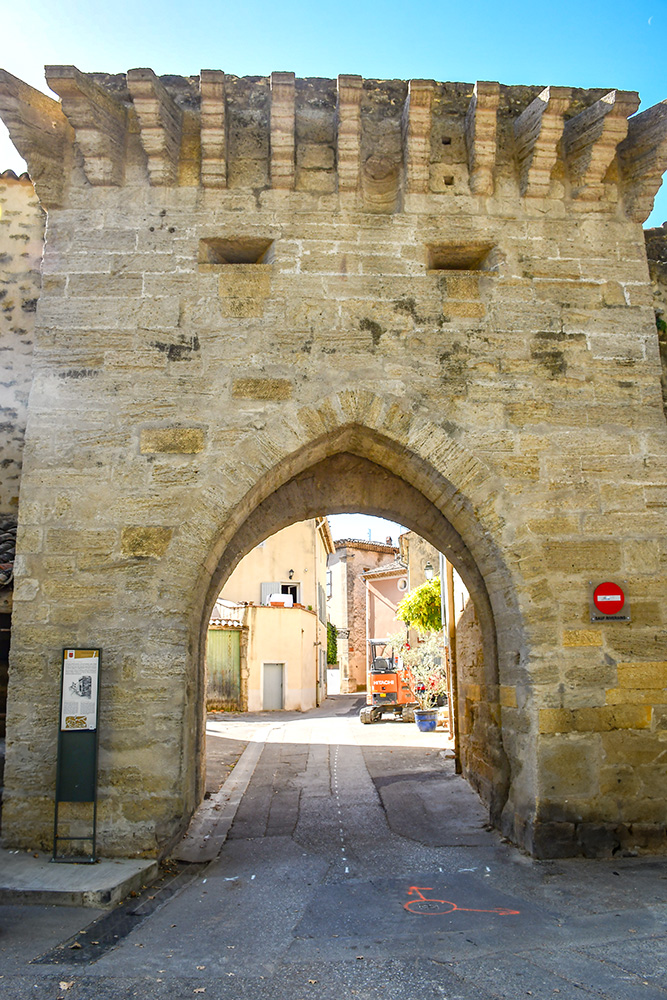
Portail de l'Étang © French Moments
It was once called “Portail de Cabrières” or “Porte de la Burlière”, the name of the neighbouring district. In Provençal, “burlière” refers to a place where people played a game of boules.
You can still see the openings through which the drawbridge chains passed.
The Ice-House
Follow the Rue de la Montée du Château-Vieux, towards the Tour de la Citadelle. There you will discover the ruins of the Glacière, the former ice house that stored blocks of ice.
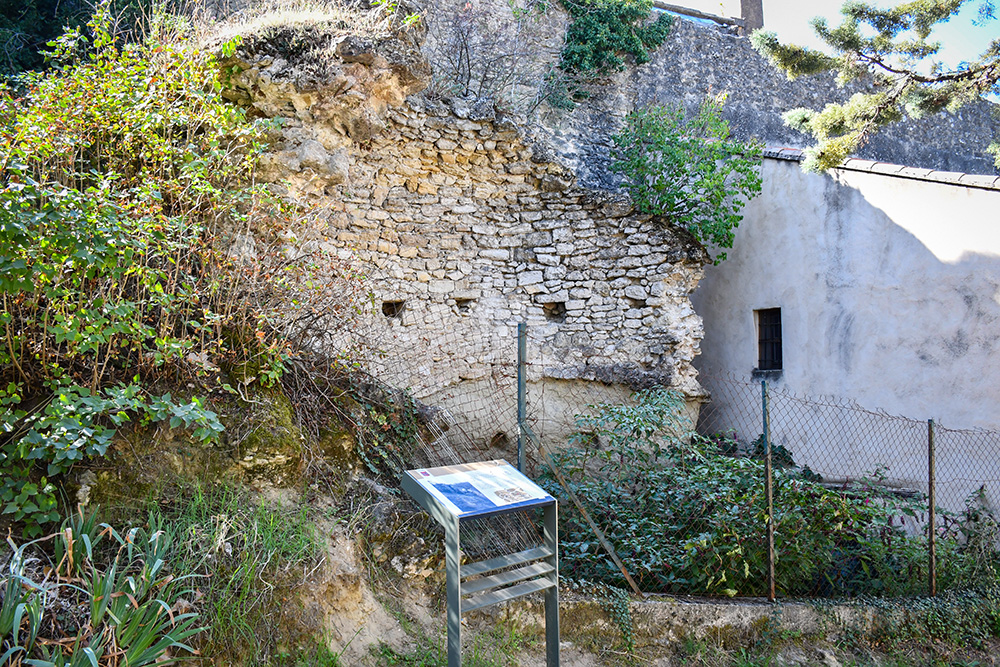
The remains of the Glacière © French Moments
The Glacière housed a tank 7 metres in diameter and 6 metres high, partially buried, built in a cylindrical shape.
Ice was used to treat haemorrhages, soothe pain and stomach aches, and reduce bruising.
But most importantly, it ensured better food preservation, especially Mediterranean fish, which were neither salted nor smoked.
The ice could be kept for at least two consecutive years.
The water in the Bassin de l'Étang would only freeze for a few days during the coldest months of the year, so the ice harvest had to be done very quickly. Thanks to its perfect internal insulation and the mass of ice contained, the ice house maintained a very low temperature even in the heart of the hottest summer.
The Citadel Tower
The Tour de la Citadelle is also known as the “Tour Sus-Pous”, meaning the tower above the Pous district. It was part of the third rampart of Cucuron, built in the 16th century.

The Citadel Tower © French Moments
At the foot of the tower, there is a magnificent panorama over the rooftops of Cucuron.
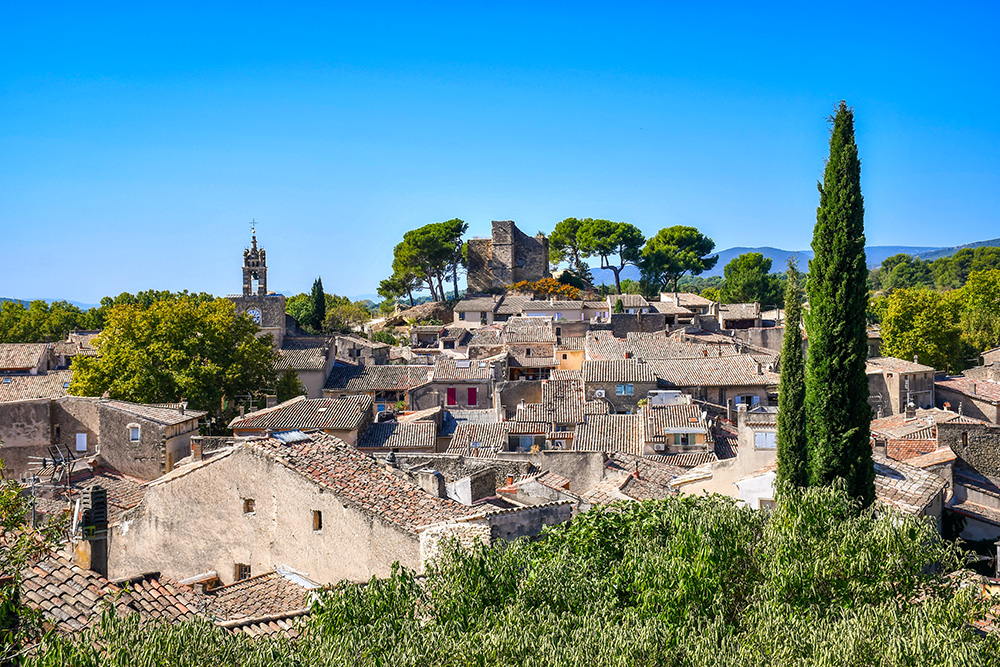
The view from the Citadel Tower © French Moments
Church of Notre Dame de Beaulieu
As the old Saint Michel church had become too small, another more spacious sanctuary was built in a close and sparsely built neighbourhood.
It's the "Pous" neighbourhood where we find ourselves, situated on a small hill 200 meters East of the fortified town.
The Notre Dame de Beaulieu church dates back to 1292 and comprises of several parts of different styles, added one after the other over the ages.
In 1587, the communal council decided to construct a bell tower on the façade, which was completed in 1624.

Chuch of Notre-Dame de Beaulieu © French Moments
Inside the Church
Its original core consists of the first three bays of the nave and the pointed barrel vaults on double arches in the Provençal Romanesque style.

The nave © French Moments
The fourth bay, of a slightly different module, is covered by a ribbed cross vault resting on sculpted bases.
The two flanking chapels and the pentagonal heart were added to the Romanesque nave around the middle of the 14th century.
Most of the furniture in the church dates from the 16th and 18th centuries.
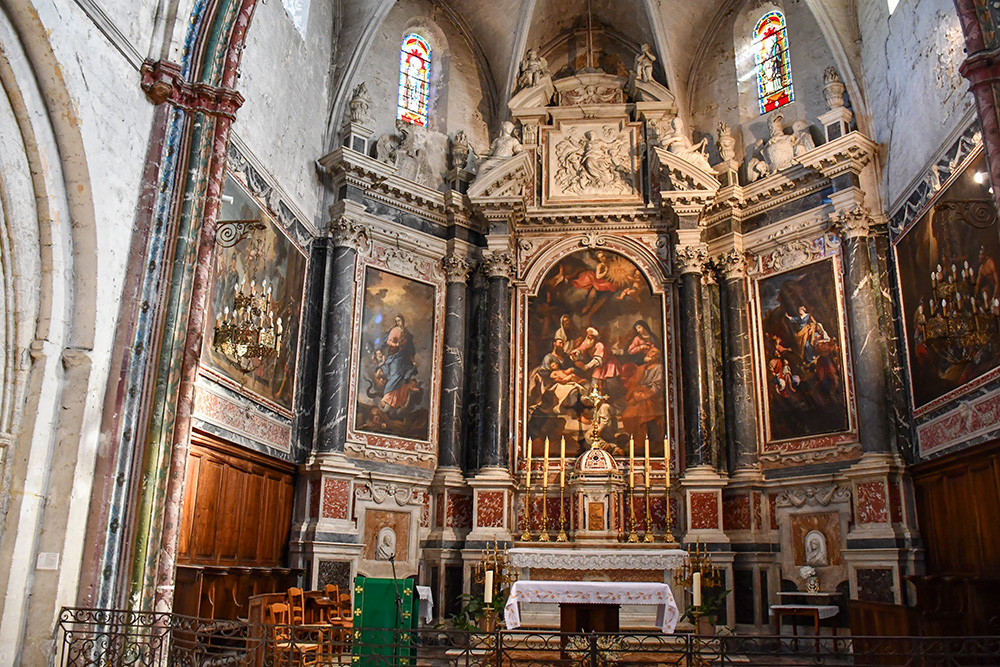
The altarpiece in the choir © French Moments
The red and gold organ case perched on a narrow gallery is a work of great elegance.
The Louis XV-style organ was built in 1786 by Pierre Duges, an organ builder in Aix-en-Provence, from an even older organ dating from 1614.

The organ © French Moments
Rue de l'Église
The Rue de l’Église is one of the main streets of Cucuron. It connects the church to the Clock tower at the Place de la Fontaine, and crosses the Pous district from east to west.
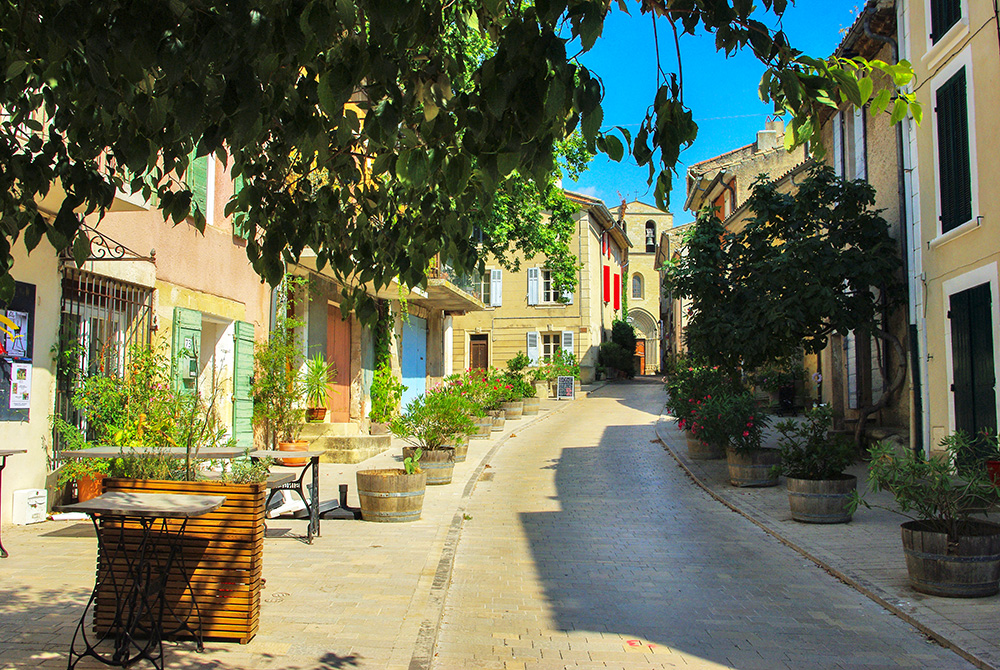
Rue de l'Église © French Moments
I'm quite fond of this neighbourhood in Cucuron; I find it very picturesque with its restaurant terraces and fine mansions.
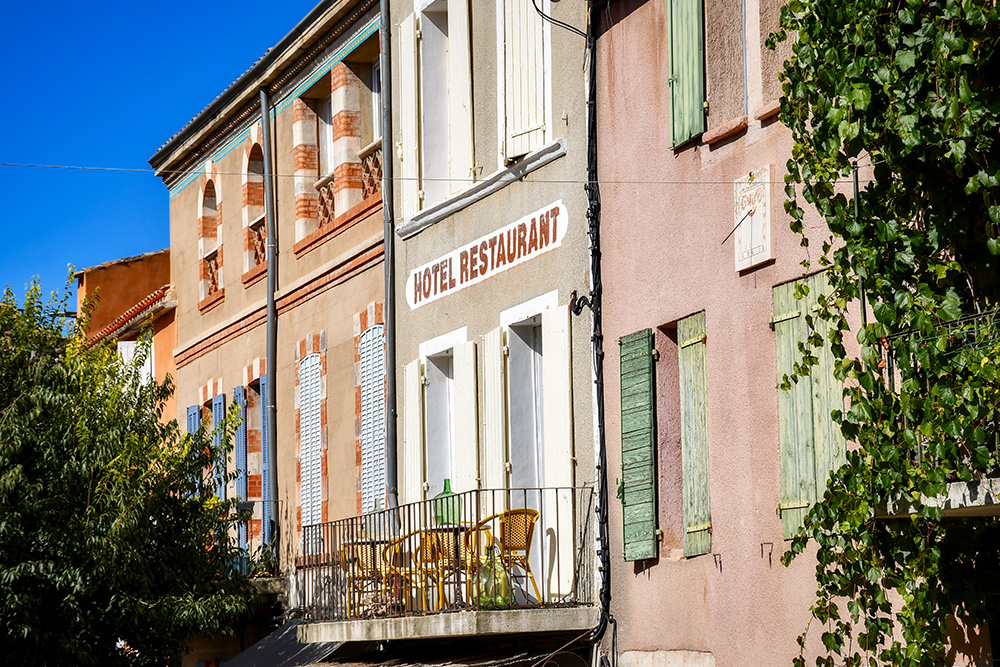
Hotel-Restaurant on the Rue de l'Église © French Moments
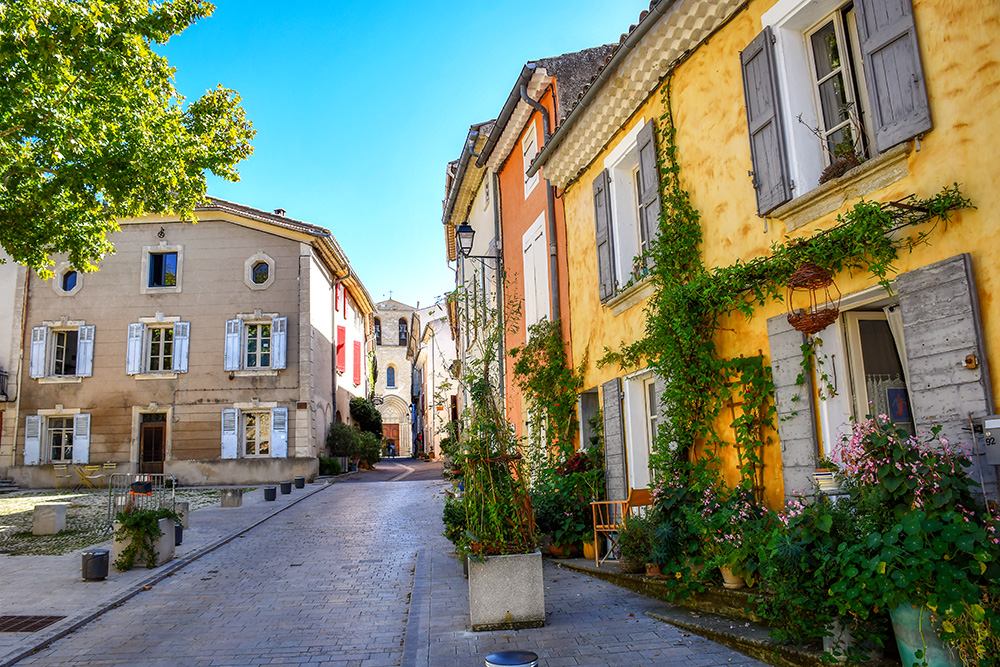
Rue de l'Église © French Moments
Hôtel des Bouliers and Marc Deydier Museum
On the left coming from the church stands the Hôtel des Bouliers, an 18th-century mansion.

Marc Deydier Museum © French Moments
Today, it houses the Marc Deydier Museum with archaeological and ethnographic collections.
The museum was created in 1970 by associations and local authorities.
It is dedicated to Marc Deydier, a self-taught notary, photographer and prehistorian (1845-1920).
Its archaeological collections feature remains from the Neolithic and Bronze Age civilisations, including an Iberian-type stele engraved with a helmet, sword and shield.
The Roman period is represented by furniture from a Roman villa (graffito of a Roman ship) and a mausoleum belonging to an aristocratic Gallo-Roman family.
In addition, several rooms of local ethnography are devoted to life in Cucuron around 1900.
Place de la Cabreyrade
The delightful Place de la Cabreyrade has one of the five covered washhouses of Cucuron.

The washhouse of Place de la Cabreyrade © French Moments
It consists of a large basin divided into two parts, fed by a fountain. The washhouse has kept its original wooden draining bar.
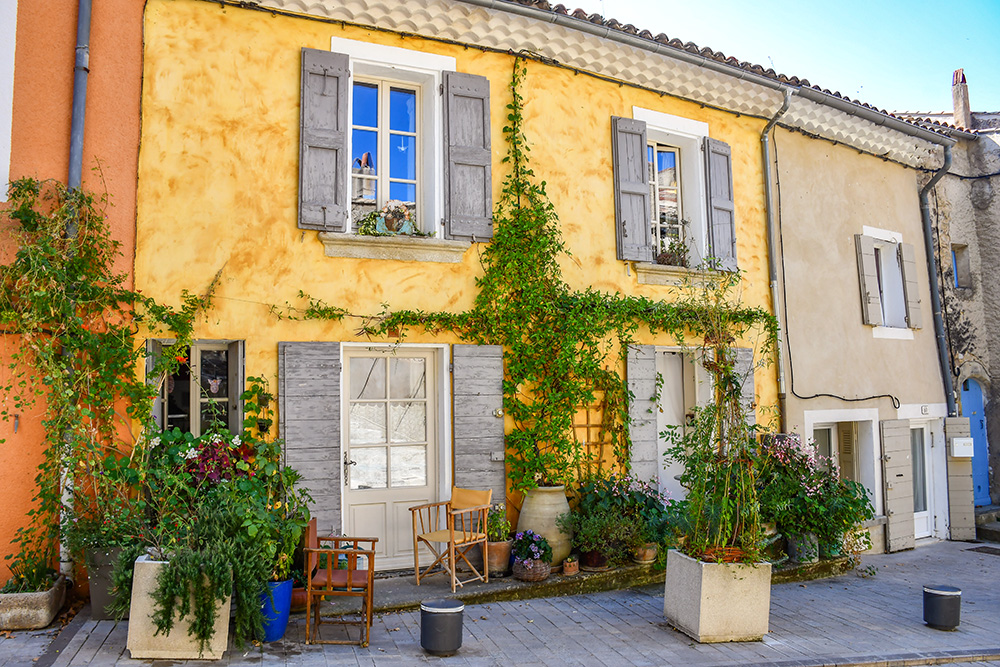
Place de la Cabreyrade © French Moments
Hôtel Bérard du Roure (Town Hall)
The Hôtel Bérard du Roure dates back to the 16th century and was remodelled in the mid-18th century.
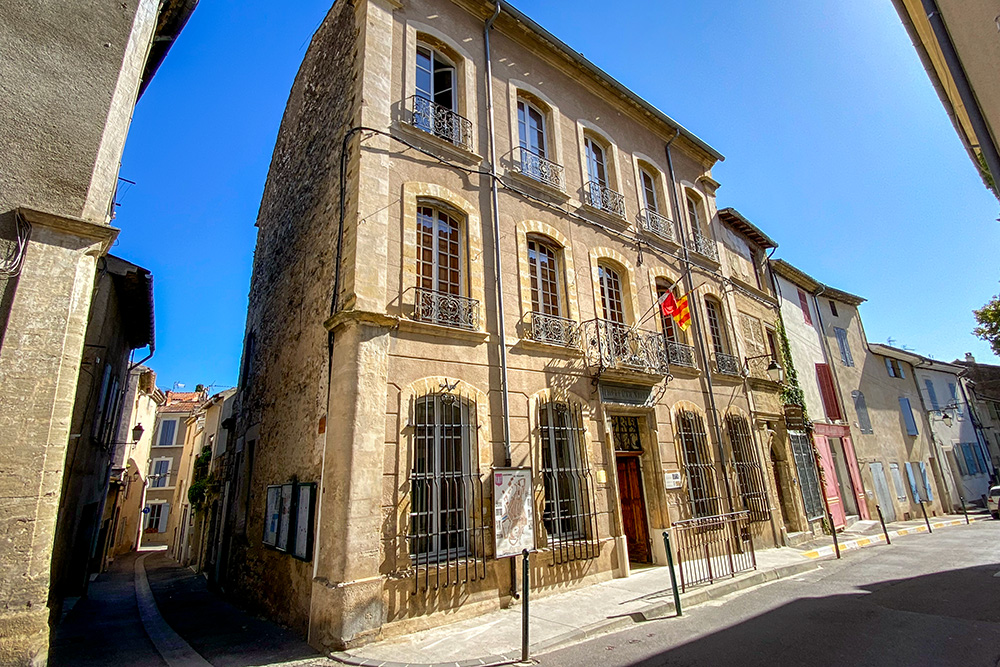
Hôtel Bérard du Roure © French Moments
Until the end of the 19th century, it belonged to the Bérard du Roure family, who played an important role in Cucuron for centuries.
Today, the mansion houses the town hall of Cucuron.
Maison des Consuls
The old house at the junction of the Rue de l'église and the Rue du Marché is called the Maison des Consuls.
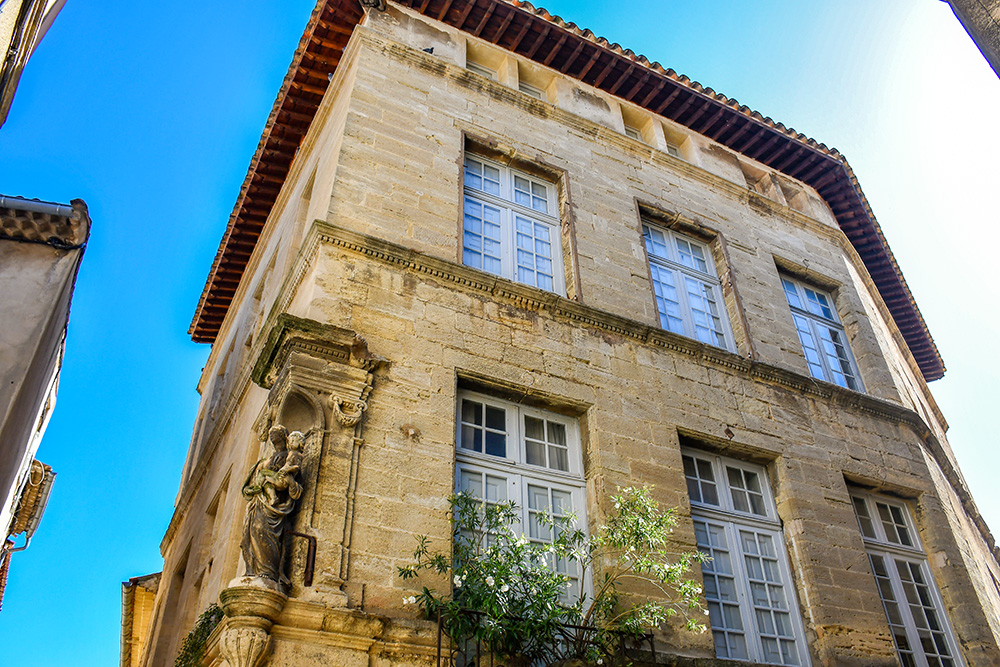
Maison des Consuls © French Moments
This house was probably built in the early 17th century. The names of its successive owners are known. However, it seems that it never belonged to the Town Hall, so its name, "Maison des Consuls” (Consuls House), is a misnomer.
A statue of the Virgin and Child adorns the niche in the corner pilaster. This limestone statue is 1m42 high and is attributed to the sculptor Berrnus de Mazan.
Place Maurice Taron
The square of Place Maurice Taron has one of the most beautiful fountains in Cucuron: the Fontaine de l’Obélisque.
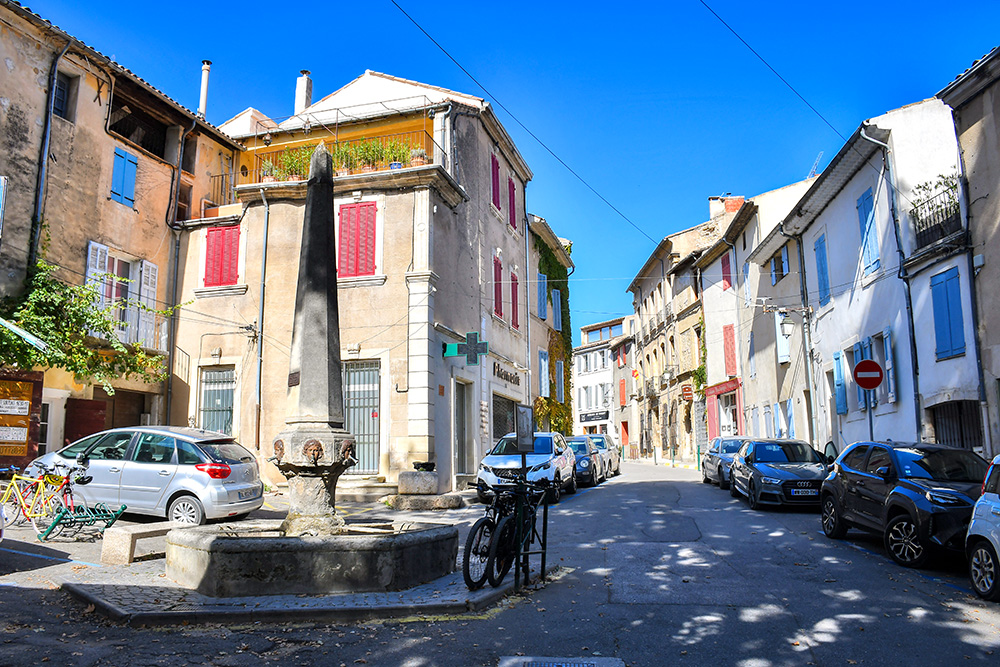
Place Maurice Taron and the Fontaine de l'Obélisque © French Moments
It's not in operation today, but you must understand that the fountain was crucial to the residents upon its completion in the second half of the 19th century.
As evidence, see the iron plaque affixed to the obelisk, which bears the inscription:
"Défense de salir l’eau" (Do not pollute the water).
Clock Tower or Belfry
The belfry of Cucuron is an old fortified gate that formed the main access in the 13th-century rampart.

The belfry of Cucuron © French Moments
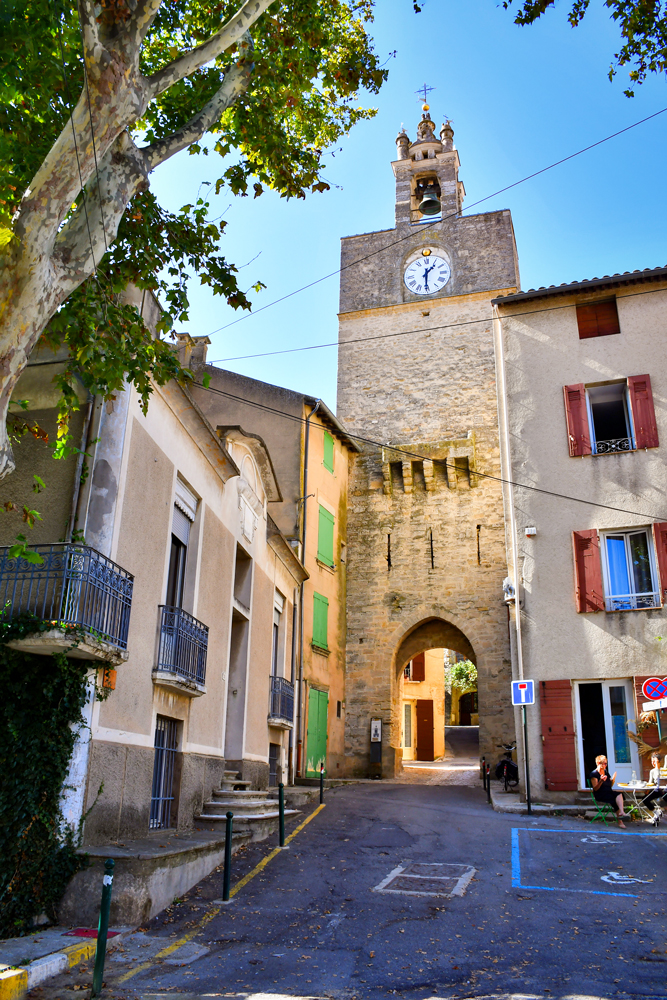
Clock tower of Cucuron © French Moments
The belfry (le beffroi) is also a clock tower (la tour de l'horloge), as the clock was built on this gate in 1541.
It is topped by a campanile, whose bell tower serves as a support for a cross.
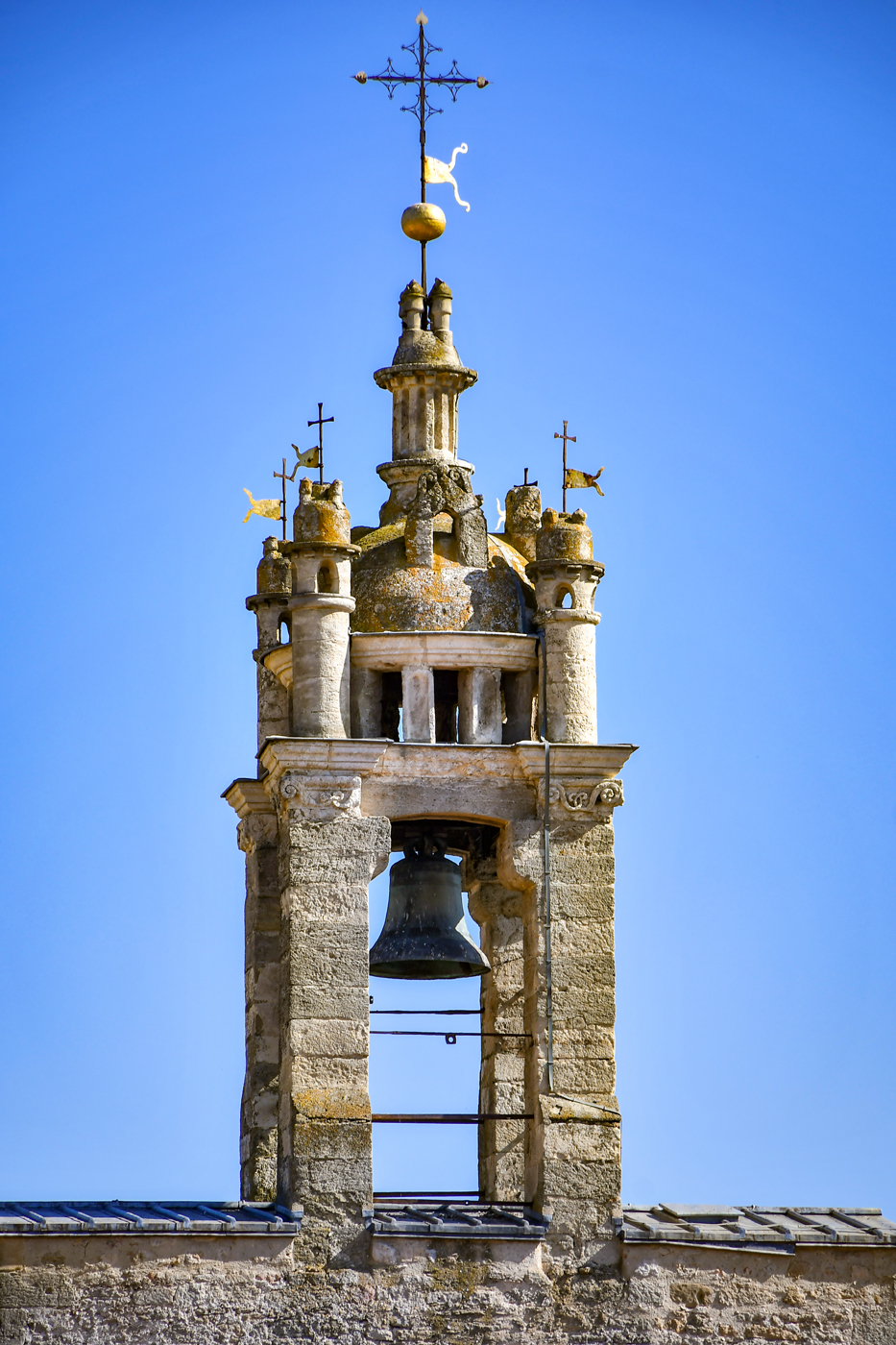
The campanile © French Moments
The Belfry's Barbarota
A long time ago, an ornament shaped like an insect could be seen beneath this cross.
The ancients used to joke that it was a "barbarota", a weevil that lived in attics.
Its symbolic presence at the top of the bell tower was supposed to protect the grain harvest, hence the local saying:
"Quand la barbarota est au clocher, es pas dins lo grenier!"
(When the barbarota is in the bell tower, it's not in the attic!)
Maison d’En-Bas des Seigneurs
On the Rue de l’Annonciade is the Maison d’En-Bas des Seigneurs (literally the lords' lower house).
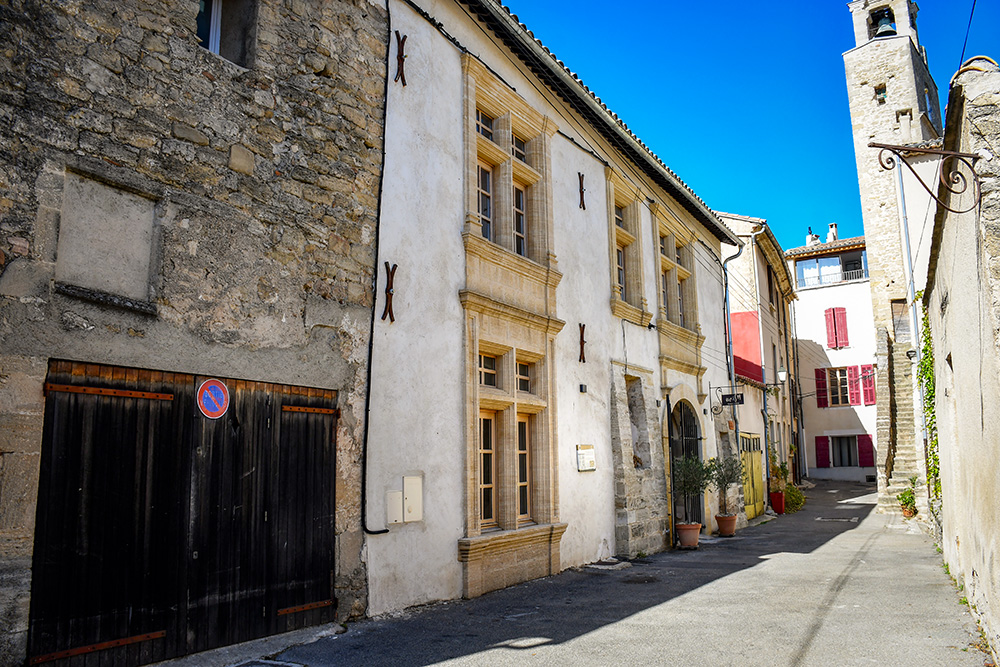
Rue de l'Annonciade and the Maison d’En-Bas des Seigneurs © French Moments
It's an old residence with a Renaissance façade belonging to the family of Castillon, Lord of Cucuron.
Rue du Tubet and the Jewry
At the end of the 13th century, when trading activities developed, Cucuron attracted a group of Jews. These were first recorded in 1299 in the Rue de la Jutarié (Jewry).
This street has since taken on its current name: Rue du Tubet, tubet meaning cabaret in Provençal.
Walking on this old narrow lane feels like being in a maze of streets.
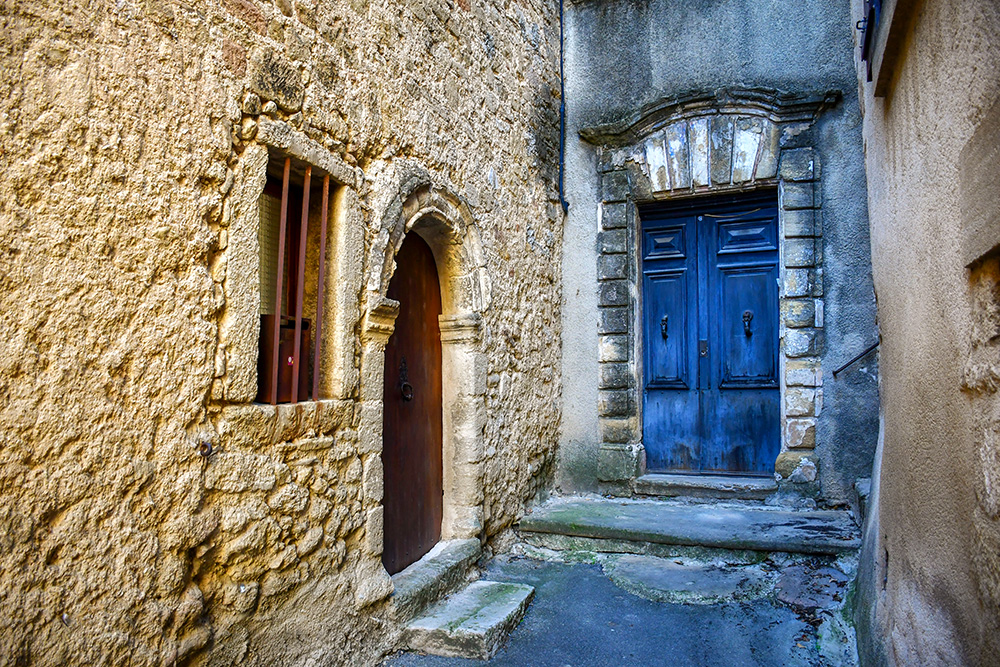
Rue du Tubet © French Moments
Maison de la Reine Jeanne
The Maison de la Reine Jeanne (Queen Joan's House) stands at the intersection with three streets and a staircase : Rue de l’Horloge, Rue du Mourre Frès, Rue des Fours and Montée du Donjon.
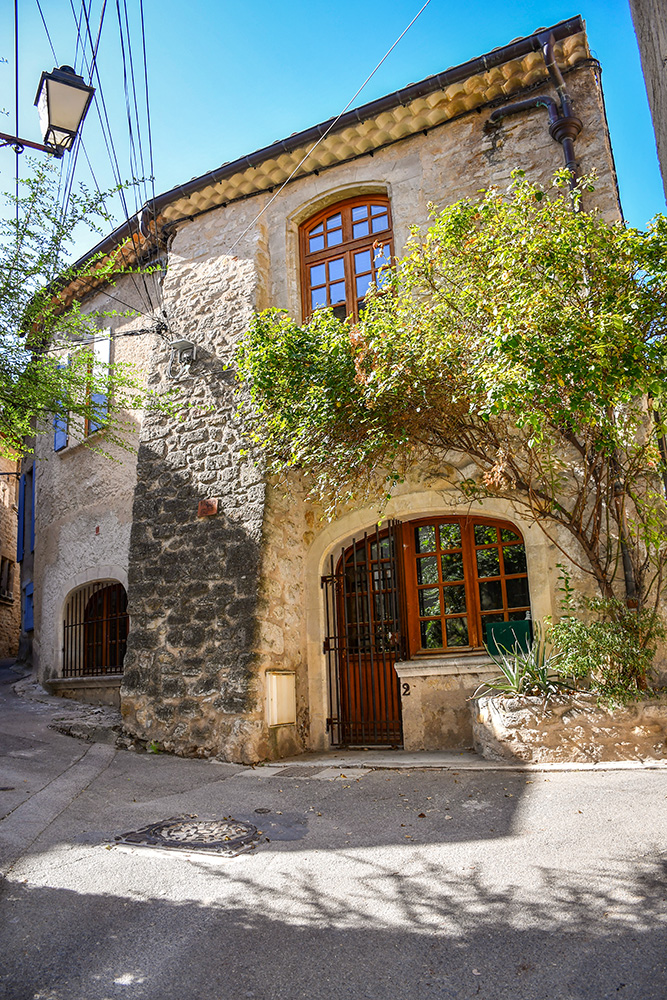
Maison de la Reine Jeanne © French Moments
The mansion is one of the oldest aristocratic houses in the old town, dating from the late 15th century.
It owes its name to Jeanne 1st, Queen of Naples and Countess of Provence in the 14th century.
She reigned over the County of Provence for nearly forty years, leaving an indelible memory with the Provençals.
That's why her name can be found in many places in Provence, such as Cucuron.
Rue du Mourre Frès
The picturesque Rue du Mourre-Frès links the Rue de l'Horloge to the Boulevard du Nord, north of the medieval town.
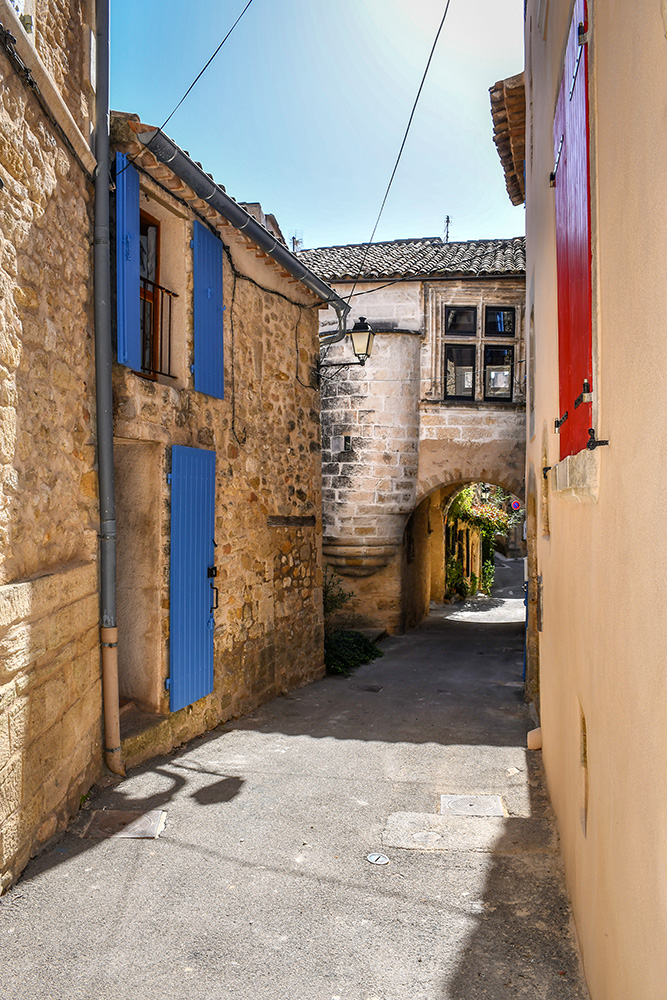
Rue du Mourre-Frès © French Moments
The street is lined with houses and cross-vaulted passageways.
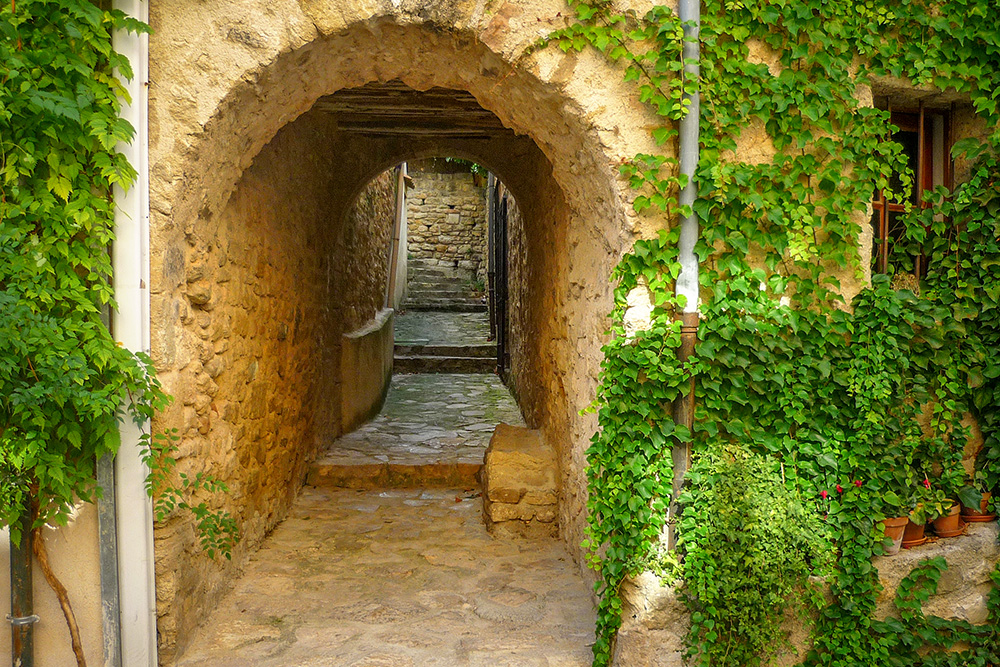
Vaulted passageway in Rue du Mourre-Frès © French Moments
Old Mairie du Trencat
The former Trencat town hall is a massive building dating from around 1400. It was built on the rampart from which the name Trencat in Provençal means "trenched" or "entrenched, perched".
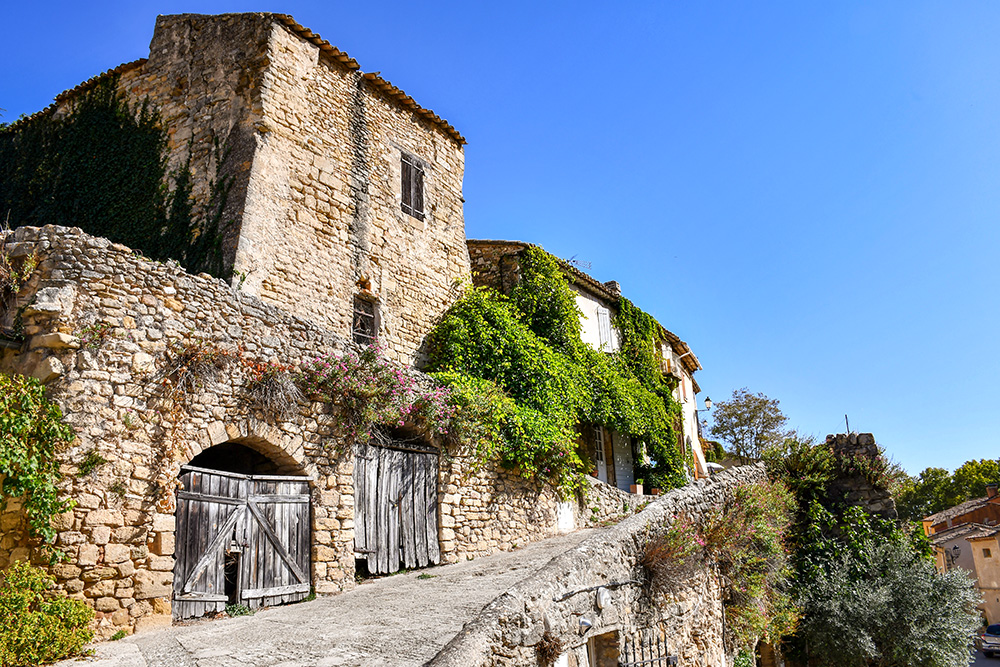
The old Mairie du Trencat © French Moments
Thanks to concessions, franchises and privileges obtained from its lords and the Counts of Provence, Cucuron became a commune, a "free fief " around the middle of the 12th century.
With its own government, the village had the right to a town hall, a municipal seal, a belfry and a bell to summon the bourgeois inhabitants to the Council.
Rue de Costo Caoudo
The Rue de Costo Caoudo stretches along the ramparts, offering lovely views over the rooftops of the suburbs and the row of plane trees on the Boulevard du Sud. It is lined with beautiful, typically Provençal houses.
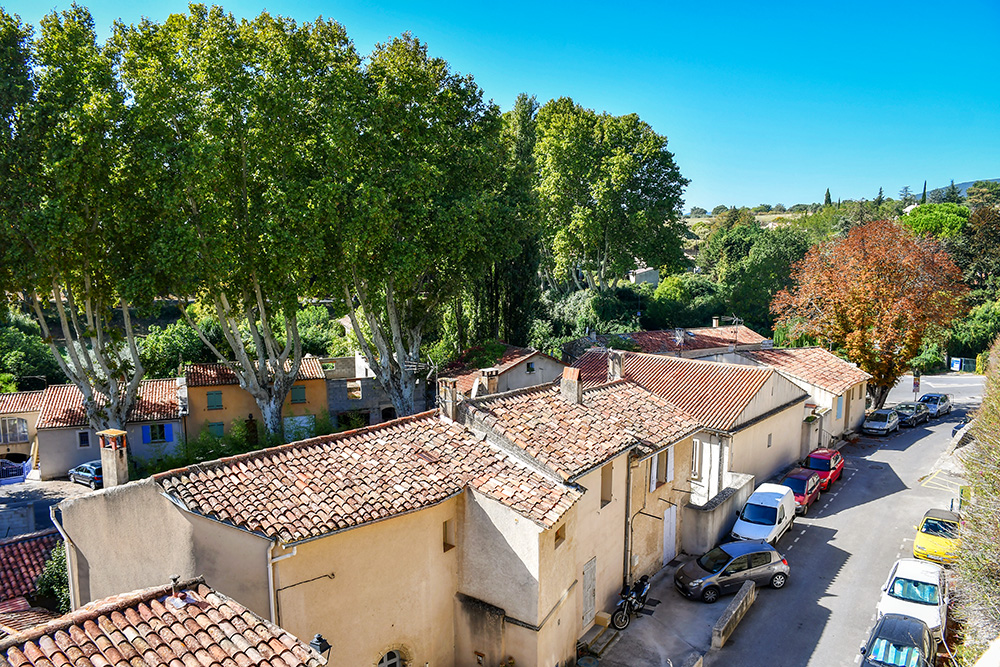
The view from the Rue de Costo Caoudo © French Moments
Donjon Saint Michel and the Panoramic View
The castle tower is locally called the Donjon Saint-Michel (St. Michel Keep). This truncated tower is the only remnant of the medieval castle.
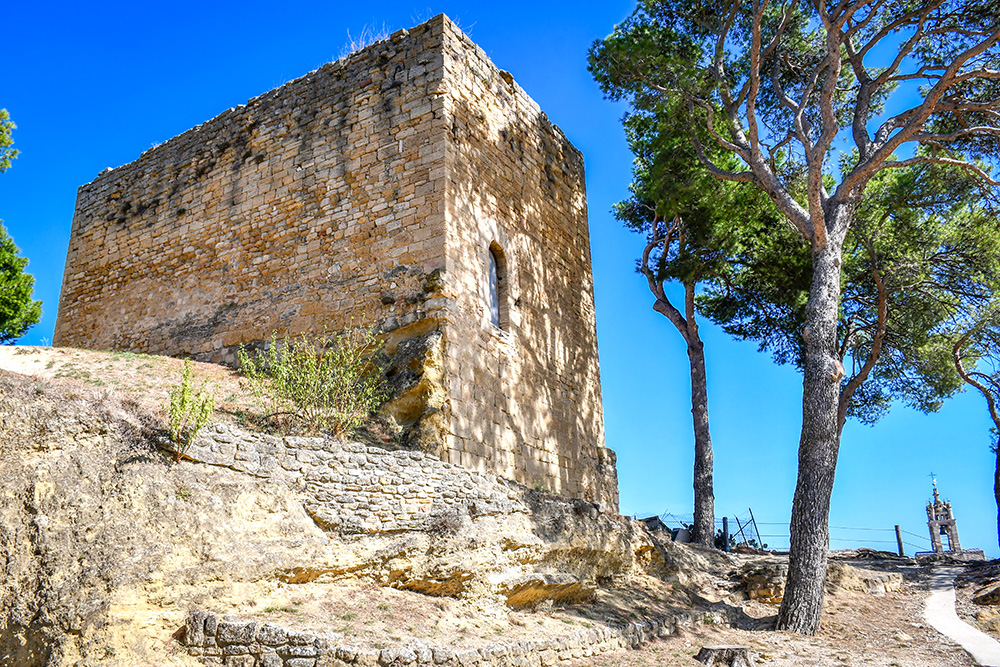
Donjon Saint-Michel © French Moments
The castle was abandoned around the middle of the 17th century and gradually fell into ruin. Its remains were sold in 1791 to a private individual and then acquired a little later by the municipality.
The panoramic view
From the top of the castle hill, the view spans over the territory of Cucuron and its surroundings.
You can see the Belfry in the foreground and in the back the Tour de la Citadelle and the church Notre Dame de Beaulieu.
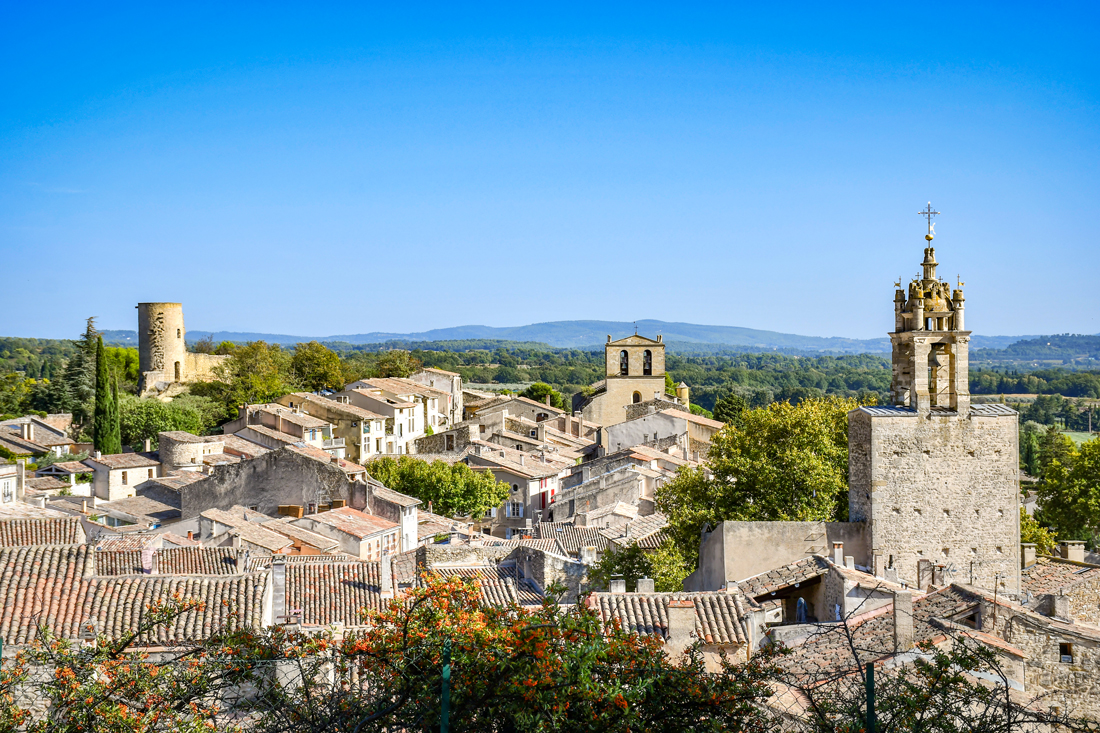
Cucuron © French Moments
To the west, the view stretches towards Vaugines and in the distance you can spot the Alpilles mountain range.
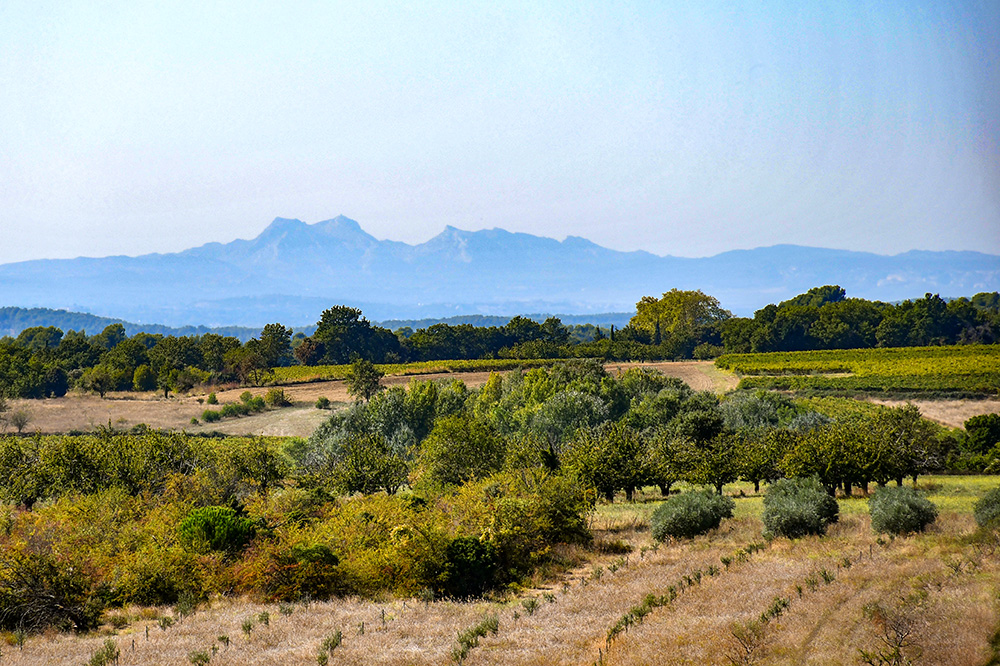
View to the Alpilles from Cucuron © French Moments
To the north, you can recognise the Luberon range to the north and the Mourre-Nègre, its highest point at 1125 metres.
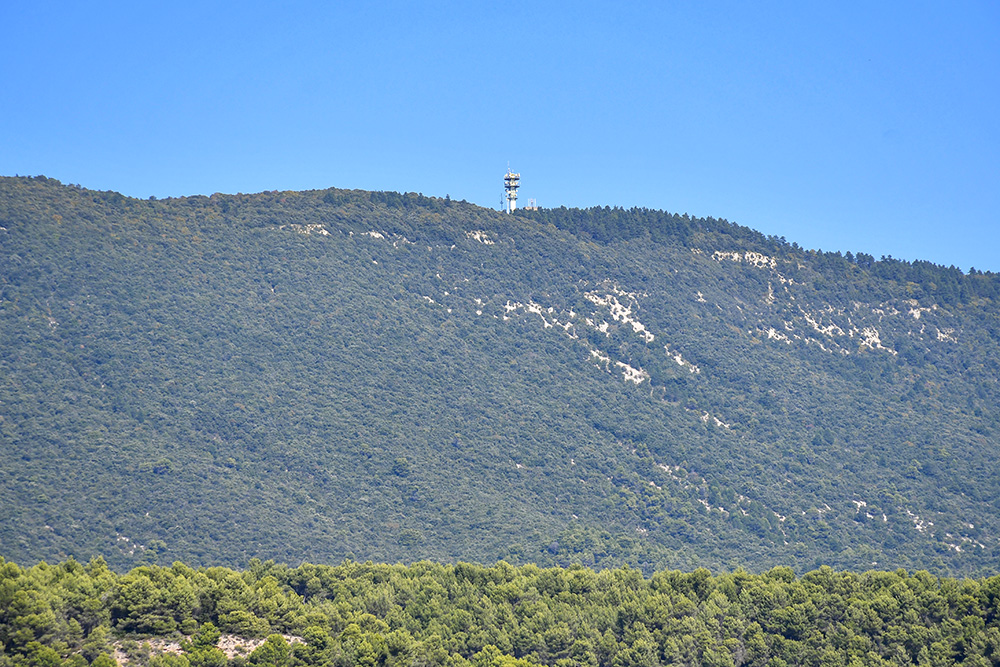
Mourre-Nègre (Grand Luberon) © French Moments
To the south-east is the beautiful village of Ansouis.

View of Ansouis from Cucuron © French Moments
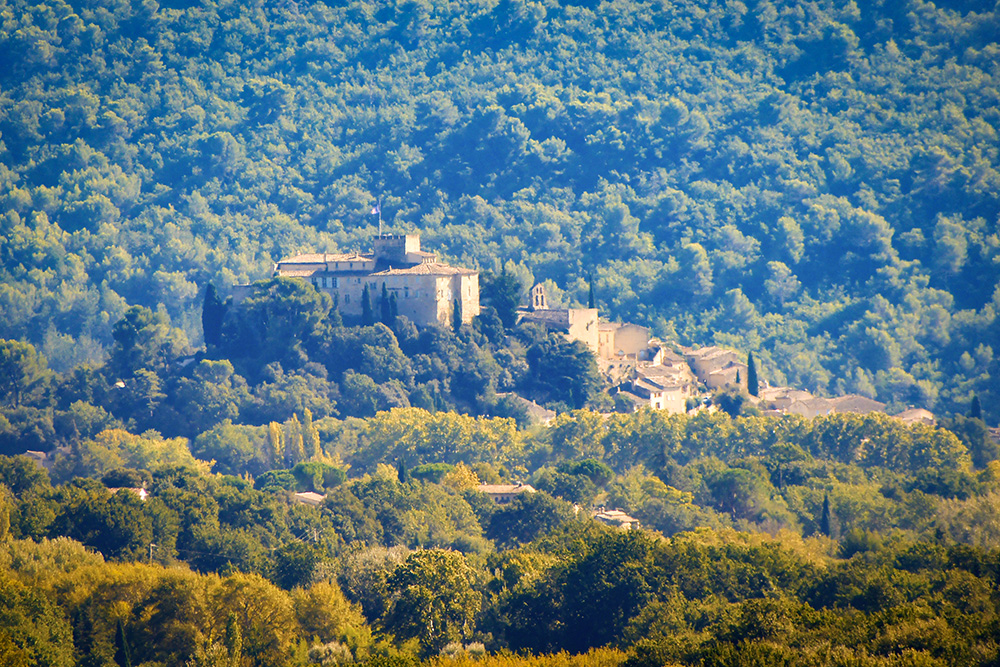
The village and castle of Ansouis from Cucuron © French Moments
In the south, the view extends to the iconic Montagne Sainte-Victoire in the vicinity of Aix-en-Provence.

Montagne Sainte-Victoire © French Moments
Come in the afternoon to have this beautiful view in the sunlight when the sun is to the west as this picturesque view makes for really cool photos.
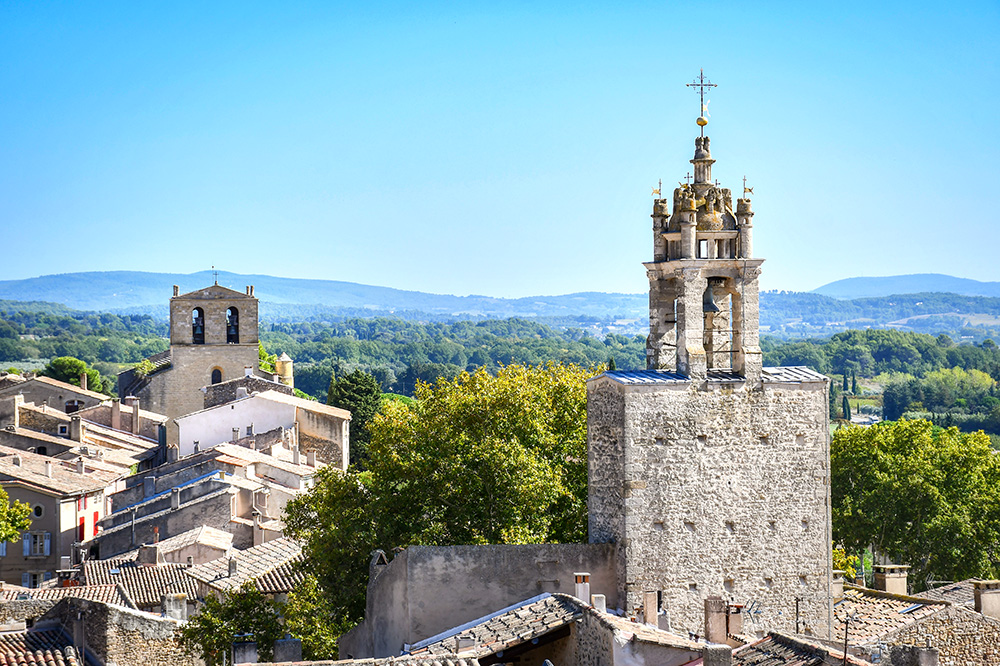
The church and the clock tower © French Moments

The church from Donjon Saint-Michel, Cucuron © French Moments
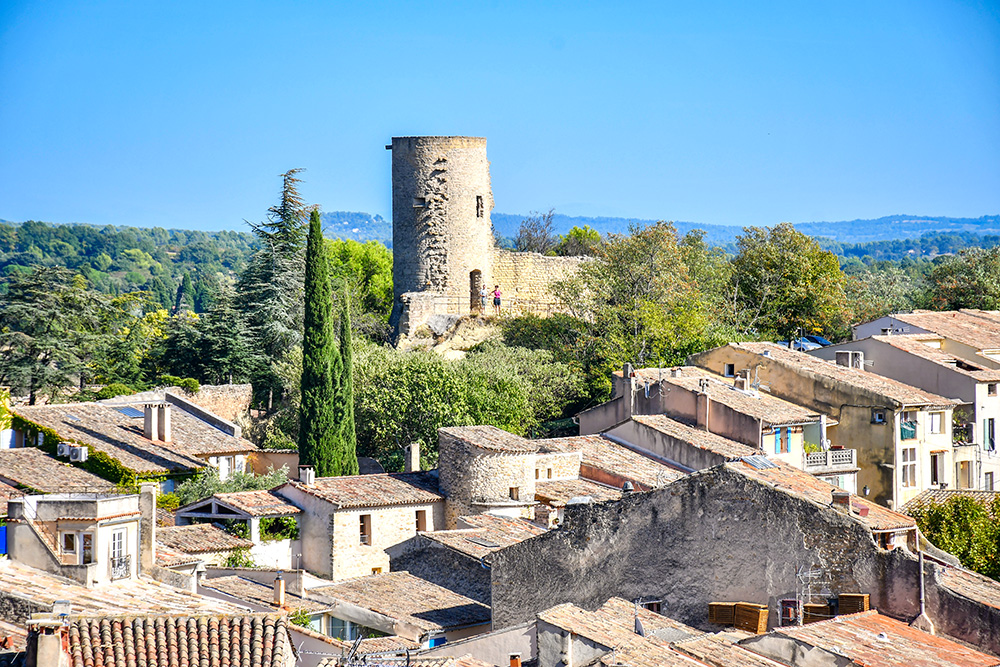
A view of the Citadel Tower © French Moments
Find out more
Here are some pages from our blog and other websites to find out more about this Provencal destination.
- Discover the hilltop villages of the Luberon
- The official website of the Mairie de Cucuron
- Explore the neighbouring village of Lourmarin
- Find out more about Provence-Alpes-Côte d'Azur
- The official tourist office of the area
Where to stay in Cucuron
Cucuron and surroundings have a high capacity for holiday accommodation. The commune has hotels, bed and breakfasts (covering all price ranges), estate agencies offering seasonal rentals and gîtes.
Click here to book your accommodation in the Luberon or browse the map below:
What to do in the Luberon
Be inspired by a list of things to do in the Luberon:
Pin Cucuron on Pinterest





